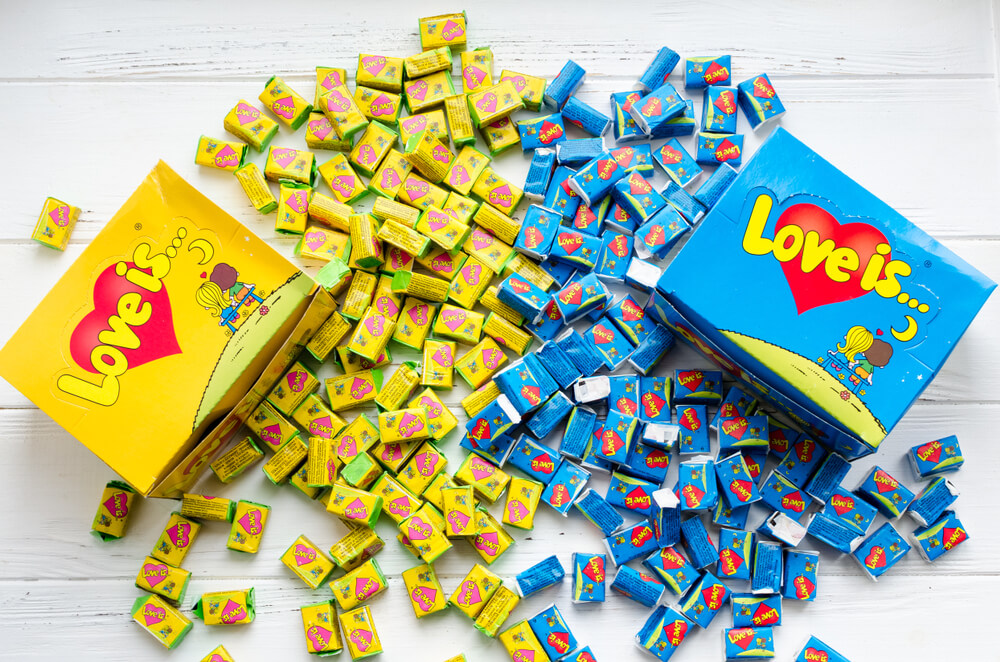'Love is…': the tragic story of the couple who created the iconic gum
Many of us collected Love is chewing gum inserts as children, which told about what true love is. However, not everyone knows that the touching cartoon characters had real prototypes: the girl is the New Zealand artist Kim Grove, and the dark-haired boy is her husband, Italian Roberto Casali, reports Marie Claire.

Photo: Shutterstock
In the late 1960s, hippie culture was at its peak in Western society. Its representatives adhered to pacifist views and sang love. It was under the influence of this ideology that the New Zealand artist Kim Grove grew up. When she was 19 years old, she went on a journey around the world. And six years later, Kim settled in sunny California. One day she went to a ski club in Los Angeles, where she noticed a man at the sight of whom her heart began to beat faster. Roberto Casali - a handsome Italian and a successful engineer - at first did not pay attention to a young and modest girl. And Kim was embarrassed to take the first step and openly get to know him. Instead, she began drawing cute pictures on napkins of a little girl with freckles and a dark-haired boy getting into funny situations on the ski slope and sending them to Roberto. The artist accompanied each drawing with the caption “Love is…” (“Love is…”), after which there was another interpretation of the most beautiful feeling in the world.
“I started making little drawings to express how I feel…” Kim later said. - First I drew a droplet that became a girl, it should have been me. She experienced all these fantastic feelings. Then I drew another drop - the boy who was the cause of these feelings.
The pictures made a huge impression on Roberto, and, of course, he was intrigued by the personality of their author. He invited Kim on a date and very soon fell in love with this talented girl, who feels love so subtly. All the pictures that she sent him, he carefully saved. It seemed to Roberto that these touching "confessions", made on small pieces of paper, were a real treasure that he was lucky to receive as a gift. Kim, embarrassed, brushed aside his compliments: she saw no value in them other than the fact that they helped her meet the man of her dreams. But Roberto was determined to help his beloved fully realize her wonderful gift. He agreed with his friend a journalist from the Los Angeles Times, and on January 5, 1970, Kim's work was first printed on the last page of a popular American newspaper.
The audience was fascinated by the comics of the New Zealand artist - all of America started talking about them. Soon, cartoonish pictures of lovers began to be printed not only in newspapers, but also on souvenirs - mugs, calendars, postcards, magnets, T-shirts, napkins, and even playing cards. In the wake of the popularity of the "Love is ..." series, the film "Love Story" was released, based on the novel of the same name by Eric Siegel. Its slogan was a phrase strongly reminiscent of Kim Grove's romantic messages: "Love is ... when you don't have to apologize."
Meanwhile, Kim and Roberto's relationship has moved to a new level. The man proposed to his beloved. However, before agreeing, she took one promise from him. “My father died when I was young,” Kim said. “So when Roberto asked me to marry him, I agreed, but said: “Whatever you do, don’t die on me.” He laughed and promised he would try."
On the subject: Netflix made a series about a Russian swindler: a luxurious life and million-dollar scams
Their wedding took place on July 24, 1971 in New Zealand. They exchanged vows under the vaults of the small church where Kim's parents had married 35 years earlier. The artist completed her wedding look with a charming daisy wreath, and the same accessory soon appeared on the heroine of her famous comics. In such a touching way, Kim “documented” everything that happened in her life with Roberto: over time, the cartoon characters of the artist knew all the joys of parenthood (in 1971, Kim gave birth to two sons), got pets, learned to create a joint life and be happy, despite for what.
In January 1972, Minikim, created by Roberto, licensed "Love is..." comics, which continued to grow in popularity. Subsequently, they were published in 50 countries around the world.
But in 1975, the family happiness of Kim and Roberto was shaken: the man was diagnosed with cancer at the last stage. This was a huge blow for the couple. The artist put aside work on the Love is... series and devoted herself entirely to caring for her husband. In order not to upset comic book fans, she asked English animator Bill Asprey to draw cartoon pictures for her using her nickname. And she herself spent days and nights in the hospital next to her lover. “I spent the next year looking for a cure, trying to keep him [Roberto] out of the bad news,” she recalled.
The doctors decided to operate on the man, but warned the couple that even if the surgery prolongs the life of the man, he will still remain infertile. Then Kim and Roberto, dreaming of another child, decided to freeze the man's genetic material before he went to the surgeon's table. Unfortunately, the operation did not bring positive results. In 1976, Roberto died, and in the Love is ... comics, only the girl Kim and the tombstone remained.
Kim had a hard time dealing with this loss. And yet, she decided to fulfill their common dream with Roberto and give birth to a child using the genetic material of her lover. 16 months after the death of her husband, Kim became the mother of a boy named Milo. This event was reflected in the artist's comics: on the new postcard, the girl stood next to the stroller, and the caption read: “We are glad to introduce Milo Casali. Parents: Kim and Roberto (posthumously, via artificial insemination)."
Fans began to congratulate their beloved artist, and British newspapers dubbed Milo a "wonder child." However, there were those who condemned Kim's act: the religious community and representatives of the Vatican said that the artist did not have the right to give birth to a child from her deceased spouse, because this is contrary to Christian morality.
To criticism, Kim replied: “Roberto and I really wanted to give our two sons a brother or sister. Now, thanks to the care and patience of doctors, this has become possible: I received another reminder of my wonderful husband ... It's nice here thanks to the love of his mother and father. If someone condemns this, it means that the world has lost its sense of proportion. We tried to have a baby through artificial insemination before Roberto's death. If my husband were alive, Milo would have been conceived in marriage. What changes the death of Roberto?
Soon, Kim and her sons moved to Australia and bought a farm near Sydney, where she began to breed Arabian horses. She died in 1998, and her son Stefano took over Minikim. Kim never returned to the "Love is ..." series, but Bill Asprey continued her work. Until 1978, the English animator adhered to the black and white style of the comic book creator, but then he decided to take a chance and released the first color pictures about the love of a boy and a girl. The fans greeted them enthusiastically. Since then - for more than 40 years - Bill Asprey draws one picture "Love is ..." every day from Monday to Saturday. The artist admits that he draws inspiration not only from the love story of the creator of the series, but also from hundreds of thousands of other people who send him letters from all over the world.

Photo: Shutterstock
It is curious that for a long time Bill did not suspect that the Turkish company Dandy Sakiz began to produce chewing gum "Love is ..." with his comic inserts. In 2008, a correspondent from one of the Russian newspapers called the artist for an interview, and he was surprised to learn that he had become popular in Russia thanks to pictures made from chewing gum. It took several years to negotiate with a Turkish manufacturer that produced a product without the permission of the copyright holders. Eventually, Kraft Foods (now Mondelez International) bought the Dandy Sakiz factory and relaunched the chewing gum with official copyright.
You may be interested in: top New York news, stories of our immigrants, and helpful tips about life in the Big Apple - read it all on ForumDaily New York.
Despite the fact that the prototypes of the main characters are no longer alive, the comics "Love is ..." continue to exist and teach us to appreciate our beloved.
“Love is in everything that surrounds us, you just need to learn to see it,” the artist’s son, Stefano Casali, is convinced.
Read also on ForumDaily:
Ice cream, pies and shrimp: hazardous products are recalled in the US
15 most beautiful places in America to visit in spring
Subscribe to ForumDaily on Google NewsDo you want more important and interesting news about life in the USA and immigration to America? — support us donate! Also subscribe to our page Facebook. Select the “Priority in display” option and read us first. Also, don't forget to subscribe to our РєР ° РЅР ° Р »РІ Telegram and Instagram- there is a lot of interesting things there. And join thousands of readers ForumDaily New York — there you will find a lot of interesting and positive information about life in the metropolis.











